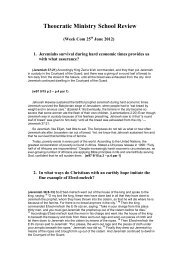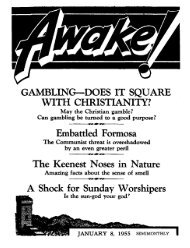1964 Awake! - Theocratic Collector.com
1964 Awake! - Theocratic Collector.com
1964 Awake! - Theocratic Collector.com
You also want an ePaper? Increase the reach of your titles
YUMPU automatically turns print PDFs into web optimized ePapers that Google loves.
-FABRIC FOR<br />
YOUR ENJOYMENT<br />
Hop aboard our red-and-yellow jeepney<br />
and <strong>com</strong>e with us on a trip along<br />
the provincial highway in southern Mindanao.<br />
The poblllci6n behind us is Digos and<br />
this is the province of Davao, noted for its<br />
abaca fiber and its exotic durian fruit. Davao<br />
also supplies the Philippines with much<br />
of its lumber and coconut. But we arc not<br />
going to tour its abaca plantations nor its<br />
durian orchards, its timber concessions<br />
nor its coconut groves. We have something<br />
else in mind.<br />
Let us slow down and take a look around<br />
us. Do you sec those ugly plants, with<br />
dark-green leaves, white and furry underneath?<br />
They look like scrawny weeds in<br />
the sunlight. Were you to find one such<br />
plant in your garden bact:: home you would<br />
probably call it a nettle, pull it up by the<br />
roots and burn it in the rubbish heap. The<br />
botanist will tell you not to be so hasty.<br />
In Davao nobody cuts it down, at least not<br />
till harvesttime.<br />
To see why, let us pull over to the side<br />
of the road and take a good long looli at<br />
the plant. That's right, it is a member of<br />
the nettle family, but it is no weed. Strip<br />
it of its fuzzy leaves-which are fine for<br />
cattle feed-and its equally fuzzy cortex<br />
and you will find running from the base<br />
to the tip of the plant strands of tough<br />
24<br />
By "<strong>Awake</strong>l"<br />
c.orrespondent<br />
in<br />
the Philippines<br />
glossy fiber, finer<br />
than abaca. Yet, unlike abaca, they can<br />
be woven into fabrics worthy of a sultan's<br />
wardrobe. This is what we came to Mindanao<br />
to see-this wonder fiber, ramie.<br />
People in the textile industry call it the<br />
strongest natural fiber on earth.<br />
Let's walk over to that big shed in the hacienda.<br />
This must be harvesttime, because<br />
the tractors and the long-horned carabaos<br />
arc hauling in thick piles of cut ramie<br />
for stripping. With the permission of the<br />
kind haccndero, we <strong>com</strong>e closer; but he<br />
says that we should cover our mouths and<br />
noses with a handkerchief and wear some<br />
glasses to protect the eyes. Workers are<br />
busy at the stripping machines, locally<br />
known as lwg-utan, and the air is thick<br />
with flying fuzz. Over there in the yard<br />
ramie fibers, three to four feet long, are<br />
drying in the sun.<br />
To these hard-working people the ramie<br />
means rice and meat and the clothing on<br />
their children's bodies. To the Davao businessman<br />
it means recovery from losses suffered<br />
when his abaca plantations were almost<br />
ruined by mosaic disease in the early<br />
1950's. To the country as a whole ramie<br />
means money earned in foreign markets.<br />
The Philippines grows a fine quality of<br />
ramie. However, ramie is not grown only<br />
AWAKE!




